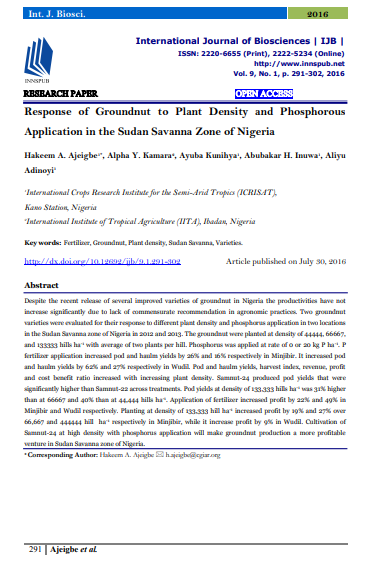Response of Groundnut to Plant Density and Phosphorous Application in the Sudan Savanna Zone of Nigeria
Summary
Despite the recent release of several improved varieties of groundnut in Nigeria, groundnut productivity has not increased, due to the lack of commensurate recommendations in agronomic practices. Two groundnut varieties were evaluated for their response to different plant densities and phosphorus applications at two locations in the Sudan Savanna zone of Nigeria in 2012 and 2013. The groundnut varieties were planted at a density of 44,444, 66,667, and 133,333 hills ha-1, with an average of two plants per hill. Phosphorus was applied at a rate of 0 or 20 kg P ha-1. P fertilizer application increased pod and haulm yields by 26% and 16% respectively in Minjibir. It increased pod and haulm yields by 62% and 27% respectively in Wudil. Pod and haulm yields, harvest index, revenue, profit, and the cost benefit ratio increased with increasing plant density. Samnut-24 produced pod yields that were significantly higher than Samnut-22 across treatments. Pod yields at a density of 133,333 hills ha-1 were 31% higher than at 66,667 and 40% higher than at 44,444 hills ha-1. The application of fertilizer increased profits by 22% and 49% in Minjibir and Wudil respectively. Planting at a density of 133,333 hills ha-1 increased profits by 19% and 27% over 66,667 and 444,444 hills ha-1 respectively in Minjibir, while it increased profits by 9% in Wudil. Cultivation of Samnut-24 at a high density with phosphorus application will make groundnut production a more profitable venture in the Sudan Savanna zone of Nigeria.
Open resource Download resource Access resource on external site

